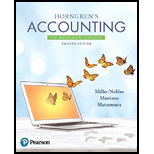
Concept explainers
Comparing amounts for cost of goods sold, ending inventory, and gross profit—FIFO and LIFO
Learning Objective 2, 3 2. Ending March. Inv. $73
Assume that Toys Galore store bought and sold a line of dolls during December as follows:
____________________________________________________________
Dec. 1 Beginning merchandise inventory 13 units @ $ 9 each
8 Sale 8units@$22each
14 Purchase 16 units @ $14 each
21 Sale 14 units @$ 22 each
_____________________________________________________________
Requirements
1. Compute the cost of goods sold, cost of ending merchandise inventory, and gross proM using the FIFO inventory costing method.
2. Compute the cost of goods sold, cost of ending merchandise inventory, and gross profit using the LIFO inventory costing method.
3. Which method results in a higher cost of goods sold?
4. Which method results in a higher cost of ending merchandise inventory?
5. Which method results in a higher gross profit?
Want to see the full answer?
Check out a sample textbook solution
Chapter 6 Solutions
Horngren's Accounting: The Managerial Chapters (12th Edition) (loose Leaf Version)
- Please provide the accurate answer to this financial accounting problem using appropriate methods.arrow_forwardI am searching for the accurate solution to this general accounting problem with the right approach.arrow_forwardCan you help me solve this general accounting question using the correct accounting procedures?arrow_forward
- Can you help me solve this general accounting question using the correct accounting procedures?arrow_forwardI need help solving this general accounting question with the proper methodology.arrow_forwardI need the correct answer to this general accounting problem using the standard accounting approach.arrow_forward
- Century 21 Accounting Multicolumn JournalAccountingISBN:9781337679503Author:GilbertsonPublisher:Cengage
 Cornerstones of Financial AccountingAccountingISBN:9781337690881Author:Jay Rich, Jeff JonesPublisher:Cengage Learning
Cornerstones of Financial AccountingAccountingISBN:9781337690881Author:Jay Rich, Jeff JonesPublisher:Cengage Learning


